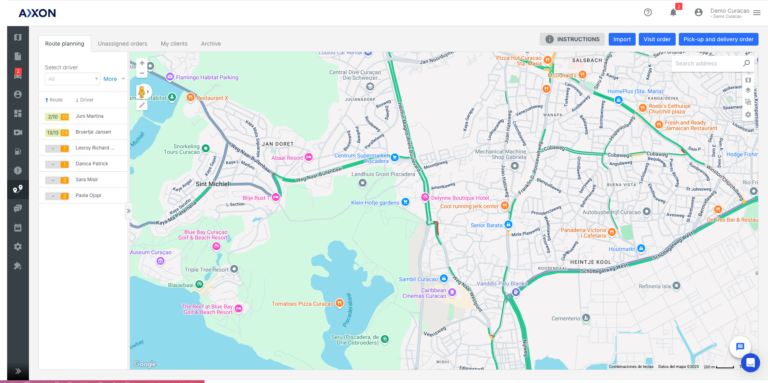Analyzing your fleet's data
But what data should you be looking at? And how can you ensure that the data you are collecting is accurate and actionable?
In this blog post, we'll look at some key data points that every fleet manager should be tracking. We'll also provide tips on collecting and analyzing this data effectively.
1. Fleet Utilization
Utilization measures how much of your fleet is used at any time. High utilization rates can indicate that your fleet is being used efficiently, while low utilization rates may suggest that you have too many vehicles or that your vehicles are not being used effectively.
High utilization rates are generally considered good for a company’s fleet performance because they indicate that the fleet is being used effectively. Vehicles that are in use more often are generating revenue for the company and helping to meet the needs of customers.
On the other hand, low utilization rates may indicate that a company has too many vehicles in its fleet, or that vehicles are not being used efficiently. When vehicles are underutilized, it means that they are not generating revenue for the company and are not being used to meet customer needs.
Low utilization rates can also indicate that the company is incurring unnecessary costs such as vehicle insurance, maintenance, and depreciation costs for the idling vehicles.
2. Vehicle Maintenance
Keep track of maintenance schedules and costs, as well as the frequency of breakdowns and repairs. This can help you identify vehicles that may need to be replaced or that may require more frequent maintenance.
Determining what constitutes a good-performing car can depend on the specific needs and goals of your company’s fleet. However, some common metrics used to evaluate the performance of a vehicle include its fuel economy, its reliability, the total cost of ownership, load capacity, speed and acceleration, safety features, and driver satisfaction.
3. Fuel Consumption
This can help you identify vehicles that are consuming more fuel than others. This information can help you make decisions about how to reduce fuel costs, like replacing older vehicles with more fuel-efficient models.
There are several decisions you can make to help reduce fuel costs for your company’s fleet. When purchasing new vehicles for your fleet, consider models with higher fuel efficiency and reduce the need for costly repairs. Optimize your fleet's route by monitoring and tracking your vehicles, as well as identifying bad driving behavior such as excessive idling or speeding.
A fleet manager can also implement a fuel card program, this can help you monitor and control fuel expenses by setting limits on fuel purchases and tracking fuel consumption by vehicles, drivers, and location.
4. Route Optimization
Analyze routes and driving patterns to identify ways to optimize routes and reduce travel time and distance. Use the data from your GPS tracking software to help you monitor the location of your fleet in real time and track their routes. This information can be used to optimize routes and reduce travel time by identifying areas where vehicles are spending too much time or traveling unnecessarily.
Communicate with drivers to identify any issues that may be affecting travel time, such as traffic congestion or road closures, and make adjustments to routes as necessary.
5. Driving Behavior
Monitor driving behavior, such as speeding, hard braking, and idling. This can help you identify drivers who may need additional training or coaching. Read all about driving behavior here.
6. Vehicle Productivity
Monitor how much cargo or goods each vehicle is transporting and compare this data to find out which vehicles are the most productive and efficient.
There are a few ways to compare cargo and goods data to determine which vehicles in your fleet are the most productive and efficient. One approach is to use a metric called the "load factor," which compares the total weight or volume of cargo transported by a vehicle to the vehicle's maximum capacity. A high load factor indicates that a vehicle is being used efficiently, while a low load factor may suggest that a vehicle is underutilized or that it is not being used to its full potential.
Another approach is to use a metric called "cargo turnover," which compares the total weight or volume of cargo transported by a vehicle over a given period to the vehicle's maximum capacity. A high cargo turnover indicates that a vehicle is being used efficiently, while a low cargo turnover may suggest that a vehicle is underutilized or that it is not being used to its full potential.
You could also use a metric called "cargo miles per gallon", which measures the amount of cargo transported by a vehicle per unit of fuel consumed. This metric can help you identify vehicles that are more efficient at transporting cargo, and can help you make decisions about which vehicles to keep in your fleet and which to replace.
In summary, using load factor, cargo turnover, and cargo miles per gallon, you can get a better understanding of how productive and efficient your vehicles are and make data-driven decisions to improve performance.
Are you being efficient?
If you're not already tracking these data points, it's time to start. Collecting accurate and actionable data is the first step in understanding your fleet's performance. That's where Axxon comes in. Start improving your fleet’s performance with Axxon. Request a free demo today to see how we can help you take your fleet management to the next level.



